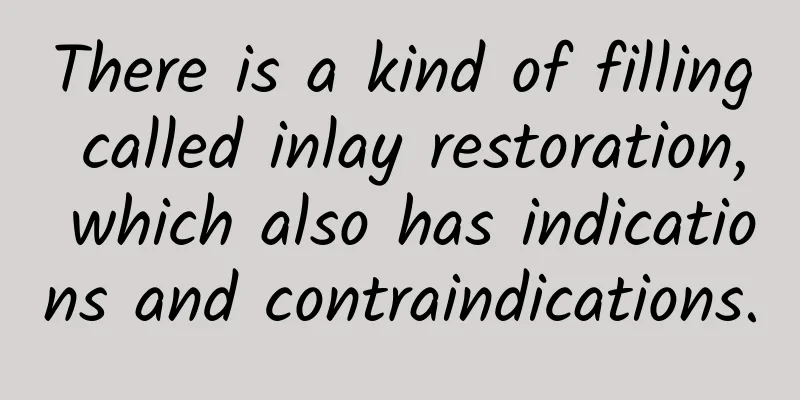There is a kind of filling called inlay restoration, which also has indications and contraindications.

|
In life, many patients who have had their teeth filled may find that: It’s only been a short time since I filled the tooth, how come the material fell off? It’s only been more than 2 months since the filling, how come food is stuck under the filling material? After only half a year of use, it's decayed again... I'm so tired. Is this dentist's skill too poor? In the above situation, you would choose the traditional method of filling teeth, right? 01. Traditional method of filling teeth? The traditional method of filling a tooth is to grind off the carious part, fill it with material, and finally polish it. During the process, the patient's saliva, gingival bleeding, and mouth opening degree of cooperation affect the doctor's diagnosis and the size of the operating space. In addition, the polymerization shrinkage of the resin material itself and the weak bonding force with the cementum and dentin, as well as the difficulty in cleaning some corners such as the gaps between teeth, the neck of the tooth, and the distal tooth surface, etc. In some other cases, the tooth decay is deep and large, and the material cannot obtain good retention and resistance, which will ultimately make the life of the filled tooth not very long, and most of them may cause material shedding and secondary caries. Dentists say that traditional filling methods are not durable for large-area caries or caries in special locations. Another filling method can be chosen - inlay. With the rapid development of oral medicine, inlays are rapidly being understood and recognized by more and more people for their advantages such as less removal of tooth tissue, good mechanical properties, good edge adhesion, and high polishability . 02. Advantages of inlays over traditional fillings The difference: After taking an intraoral impression, the inlay is designed and made by a specialized dental technician outside the mouth using digital technology or on a plaster model based on the occlusal relationship of the entire mouth and the characteristics of the affected teeth. The clinician then wears it into the patient's mouth for trimming and uses a specially formulated adhesive to bond it to complete the restoration. #1. Compared with full crowns, less tooth preparation is required, which reduces stimulation to the pulp and can restore the ideal tooth shape ; #2. The edges of the inlays are mostly located in the supragingival self-cleaning area, and the edges can be highly polished, so that plaque is not easily attached and it is easy to clean, which can prevent caries and benefit the "long-term stability" of periodontal tissues ; #3. For defects caused by proximal caries, inlays can accurately restore the position, size, and tightness of the proximal contact points , increase the compatibility between teeth and restorations, reduce or even solve food impaction, and help prevent caries; #4. Since the inlay is designed outside the mouth, the technician will fully consider the matching degree between the edge of the restoration and the affected tooth when designing, to ensure the edge closure of the restoration and further prevent the tooth from further decay; #5. Inlays can cover the cusps of teeth, which can protect the thin walls and weak cusps of teeth, increase the force-bearing area of the teeth on the restorations, prevent stress concentration, and prevent tooth fracture ; #6. Compared with the single color selection of filling materials, the color of the inlay can further fit the gradient of the original tooth , which has a better aesthetic effect; #7. Inlay is a repair method that directly bonds the defective part as a whole to the mouth. Its bonding area and force-bearing area are larger than those of simple filling treatment, and its resistance shape and retention shape are better, so it is not easy to fall off . Even if it falls off accidentally, as long as the tooth is not further decayed or damaged, it can be reattached with adhesives. This is something that traditional fillings cannot match. Although inlay fillings have many advantages, they also have certain indications and contraindications. 03. Indications for inlay fillings #1. Generally speaking, the restoration of tooth defects caused by caries in any part of the tooth is an indication for inlays; #2. The tooth defect is large and it is difficult for general filling materials to obtain good retention; #3. Tooth defects of posterior teeth due to excessive combined force; #4, tooth defects on the cusps, incisal angles, marginal ridges and occlusal surfaces of posterior teeth; #5. Poor proximal contact or severe food impaction caused by posterior tooth defects requires restoration of the interproximal contact area; #6. Teeth that need to restore crown height and shape; #7. Protective restoration of the support part of removable partial dentures; #8. The tooth defect is below the gum line, and it is difficult to obtain good marginal properties with general filling materials; 04. Contraindications of inlay fillings #1. Permanent teeth of adolescents and deciduous teeth of children that have not been treated with root canal are not suitable for inlay restoration because of the high position of the pulp horn, which is easy to damage the pulp; #2. The occlusal defect is small and shallow, so as to avoid cutting too much healthy tooth tissue; #3. The tooth defect is too large and the remaining tooth tissue cannot provide sufficient resistance and retention for inlay restoration. #4. Large areas of tooth defects result in less enamel available for bonding, making it impossible to obtain sufficient bonding strength; #5. People with abnormal occlusal function, such as bruxism, clenching teeth, etc., may cause excessive wear and easy fall of the inlay; #6, defects on the proximal and labial surfaces of the anterior teeth that do not involve the incisal angle; #7: The tooth defect on the axial surface is deep and reaches the subgingival; #8. Patients who have high requirements for aesthetics and long-term restoration effects should not undergo inlay restoration; Note: The pictures in this article are from the website, and some of the text is excerpted from the Internet. The copyright belongs to the original author. If there is any infringement, please contact us and we will delete it. |
<<: Investing Analytics: Twitter activity survey shows that Apple is still more popular than Samsung
Recommend
7 secrets hidden in the female uterus
The uterus, a pear-shaped organ in a woman's ...
Paper straws forced me to quit even drinking milk tea. Who among my family members understands me?
What can make young people quit drinking coffee? ...
What are the effects of spraying perfume on pregnant women?
Pregnant women actually need to pay attention to ...
Fumigation has many benefits for postpartum mothers
Common symptoms for postpartum mothers include jo...
Symptoms of having a boy in early pregnancy
The gender of the fetus is of great concern to mo...
[The First Brain-Computer Interface and Rehabilitation Science Competition] Brainwave Dance, Sense the Secrets of the Brain (Graphic and Text Category) Second Prize
Author: Zhang Xiaolin, Chen Songmei, Shan Chunlei...
At what age do girls start to develop breasts?
The development of children is very important to ...
Why does chocolate turn white? How long does it take to eat chocolate after it expires?
Chocolate is a mixture of many ingredients, but i...
Can I have another abortion if I get pregnant again after one month of abortion?
If there is a plan to conceive, it is recommended...
Can I eat donkey-hide gelatin cake during menstruation?
In our daily life, every female friend has menstr...
Why are the labia majora red and swollen?
The female body structure is very special, which ...
Leucorrhea with blood one or two days after menstruation
Every girl's menstrual cycle is different, an...
What is the nutritional value of red dates with walnuts? Characteristics of red dates with walnuts
It is well known that red dates have high nutriti...
What harm does cervical polyp do to the human body?
Cervical polyps are a disease that female friends...
How to deal with vulvar itching and burning pain?
Once many women experience itching and burning of...







![[Medical Q&A] Slow movements and dull expressions - is this Parkinson's disease?](/upload/images/67f0e4eecfb5b.webp)

